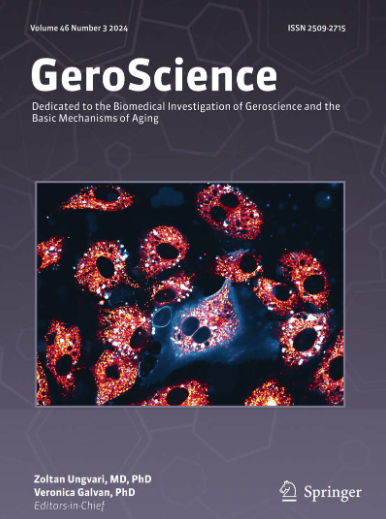Loss of microstructural integrity in left hemispheric white matter tracts is associated with poorer digits in noise understanding.
IF 5.3
2区 医学
Q1 GERIATRICS & GERONTOLOGY
引用次数: 0
Abstract
Age-related hearing loss (ARHL) is a prevalent condition among older adults and is regarded as a potentially modifiable risk factor for dementia. Although multiple studies have investigated pure-tone thresholds as a measure for ARHL and its relationship to dementia, the potential role of the central auditory system has received little attention. To address this gap in the literature, this study investigates the relationship between central auditory functioning, assessed using the speech-reception-threshold (SRT) of the digits-in-noise (DIN) test, and the microstructural integrity of white matter tracts in the Rotterdam Study. A total of 1669 participants underwent the DIN test and had diffusion imaging data available. The SRT was found to be significantly associated with the microstructural integrity of the left inferior fronto-occipital fasciculus, inferior longitudinal fasciculus, and posterior thalamic radiation. After accounting for audibility effects, the association with the inferior fronto-occipital fasciculus and the inferior longitudinal fasciculus was even stronger, while the association with the posterior thalamic radiation was no longer significant. These findings suggest that age-related declines in specific brain regions may contribute to difficulties in speech-in-noise understanding among the elderly.左半球白质束微结构完整性的丧失与手指对噪声的理解能力较差有关。
年龄相关性听力损失(ARHL)是老年人中普遍存在的一种疾病,被认为是痴呆的潜在可改变的危险因素。尽管多项研究已经调查了纯音阈值作为ARHL的衡量标准及其与痴呆的关系,但中枢听觉系统的潜在作用却很少受到关注。为了解决这一文献空白,本研究调查了鹿特丹研究中使用噪声中数字(DIN)测试的语音接收阈值(SRT)评估的中央听觉功能与白质小管微观结构完整性之间的关系。共有1669名参与者接受了DIN测试,并获得了扩散成像数据。研究发现SRT与左额枕下束、下纵束和丘脑后辐射的显微结构完整性显著相关。在考虑可听性效应后,与额枕下束和下纵束的关联甚至更强,而与丘脑后辐射的关联不再显著。这些发现表明,与年龄相关的特定大脑区域的衰退可能会导致老年人在噪音中理解言语的困难。
本文章由计算机程序翻译,如有差异,请以英文原文为准。
求助全文
约1分钟内获得全文
求助全文
来源期刊

GeroScience
Medicine-Complementary and Alternative Medicine
CiteScore
10.50
自引率
5.40%
发文量
182
期刊介绍:
GeroScience is a bi-monthly, international, peer-reviewed journal that publishes articles related to research in the biology of aging and research on biomedical applications that impact aging. The scope of articles to be considered include evolutionary biology, biophysics, genetics, genomics, proteomics, molecular biology, cell biology, biochemistry, endocrinology, immunology, physiology, pharmacology, neuroscience, and psychology.
 求助内容:
求助内容: 应助结果提醒方式:
应助结果提醒方式:


